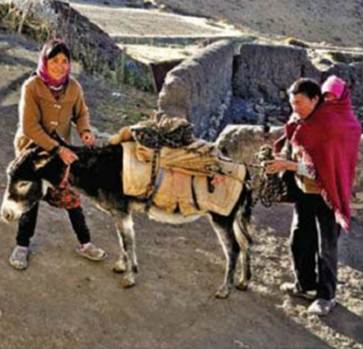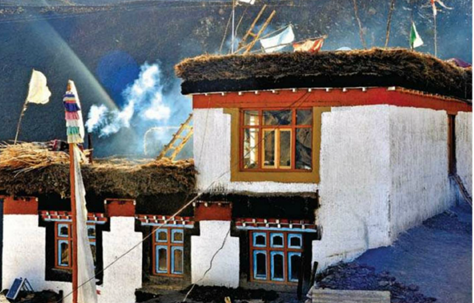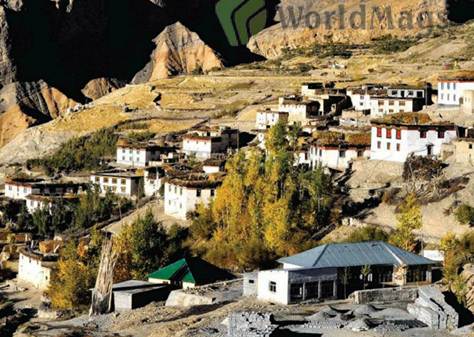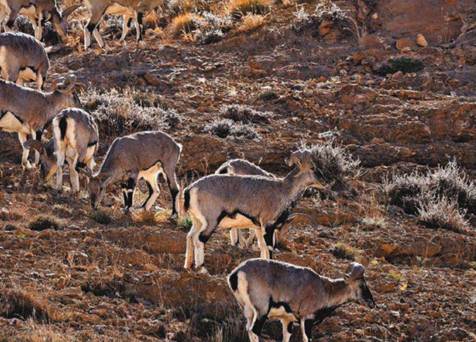A river flows across it
Above the left bank of Spiti River, in the
shadow of Himalaya’s rain, lies a beautiful and peaceful land. Covered with
snow within 6 months, with temperature falling under -25 degrees Celsius, this
highland becomes alive in such a short summer. The winter’s white blanket has
melt to reveal a verdant green which slowly turns into orange then ochre of the
autumn. Hardened hands are working on field full of green peas and wheat; yaks
and dzopkyos (hybrids of cow and yak) are wandering on pastures spotted with primulas
and anemones. In last September, we did walk along the riverside for 4 days and
enjoy significant views as well as gorgeous colors that only nature can bring.
Day 1
My companions, Paula and Sisi, travelled
from Lhangza to Komic on an autumn morning with Chau Chau Kang Nilda peak (6,303m)
left behind. The mountain was first challenged by Jimmy Roberts in 1939 and
again by Trevor Braham and Peter Holmes in 1955. Lhangza villagers believed
that bad weather would go after a successful climbing – thus they didn’t encourage
people to climb this mountain.
When we climbed down from the monastery, we
came across donkeys carrying goods and returning to home from the center of Kaza
district. Roof-tops were filled with hay for winter months.

We
came across donkeys carrying goods and returning to home from the center of
Kaza district.
Praying people’s flags, stones and horns of
ibexes or blue sheep beautified the trail (4,400m) above Hikim village. From
there, the trail plunged down into the village then headed to Komic monastery situated
on a sheer hill. This was the only visited monastery that didn’t let women in the
main prayer hall.
At Komic’s entrance lay a stuff snow
leopard which was confirmed by lamas to have been found dead around the
village.

At
Komic’s entrance lays a stuff snow leopard.

We
unexpectedly saw an abandoned house’s interesting remnants in the late
afternoon.
Day 2
Our morning started with that our guide,
Kunga Chorden, served us breakfast in his kitchen at Komic village. Meanwhile, his
parents were harnessing a donkey to visit a market at Kaza.

His
parents were harnessing a donkey to visit a market at Kaza.
On way down, we met a friendly herdsman riding
his yak to Demul village. His sheep and goats were grazing in far pastures.
Yaks, sheep and goats play an important role of villagers’ earning for living. Yak
cheese, butter and milk are used daily for home cooking when yak meat is special
food for festivals. Yak wool is used to make tents, blankets and carpets.

We
met a friendly herdsman riding his yak to Demul village.
Paula left the only path (4,700m) of Yang
Lapzey and headed towards Demul village. Kamelang peak, in Lingti valley’s
eastern side, emerged from the sky.
Approaching Chamay Lapzey’s only path, we
passed a partly-frozen stream. Water was still a rare resource in grass land
for cattle and there were every few streams to support villages.

Water
was still a rare resource in grass land for cattle.
Day 3
Homestay at Demul was interesting. The
village’s house are renovated and equipped with lights powered by solar energy.

Homestay
at Demul was interesting.

Dolma
and our guide Kunga prepared dinner in a cozy kitchen of Khabrick Homestay at
Lhalung.
After a long exhausting trip – because the
bridge below Lhalung village had collapsed – the sunny village welcomed us. Viewing
from Lhalung, on a sheer hill, we saw the gorgeous Sharkhang monastery.

The
gorgeous Sharkhang monastery
Day 4
Dhangkar monastery, around the last bend, showed
itself dramatically, embraced by spiky peaks covered with snow. From its
roof-top, we could see Spiti river’s blue veins winding through the valley.

We
could see Spiti river’s blue veins.
On way to Dhangkar, we met a herd of unruly
ibexes. Ashamed and quite, they ran away when we, with our cameras, were
approaching. Ibexes are main preys of snow leopards that are found around villages
in winter months.

Ibexes
are main preys of snow leopards.